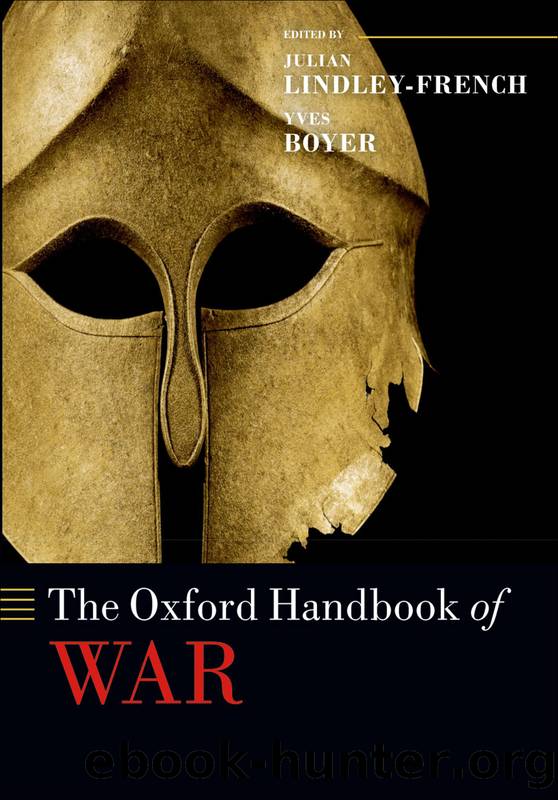The Oxford Handbook of War by Julian Lindley-French

Author:Julian Lindley-French
Language: eng
Format: epub
Publisher: OUP Oxford
Published: 2014-10-14T16:00:00+00:00
AFGHANISTAN: OPERATION HERRICK
After the Bonn Conference of December 2001, which brought together all the non-Taliban political actors in Afghanistan, it was decided to establish a UN-mandated international force to provide security in and around Kabul in order to hold elections and establish a government. NATO assumed command of ISAF (International Security Assistance Force in Afghanistan) in August 2003; before that it had depended on rotated national commands. ISAFâs mission was extended to the whole country in stages: Stage 1 was the North in December 2003; Stage 2 was the West on 10 February 2005; Stage 3 was the South on 31 July 2006; and Stage 4 was the East when ISAF assumed control of the whole country on 5 October 2006.
Arriving in Kabul as COMISAF in May 2006, I subsequently assumed responsibility from my US counterpart, Lt Gen Karl Eikenberry, for the South and then East. In the process I became the first overall, or âtheatreâ, non-US commander of a NATO force that now included a substantial number of American troops. The Americans were initially nervous about a non-American taking overall commandâthey accepted my role in the South because they didnât have anyone else but I did have to persuade the Secretary of Defense Donald Rumsfeld, largely through my actions, that I could be trusted.
There was, of course a separate American command, Operation Enduing Freedom (OEF), which was focused on counter-terror. Our mission was people-centric. Until ISAF took over the South and East, NATOâs mission was not primarily military butâand this remained the caseâthe role of the military was crucial to enable others. OEF was more kinetic, i.e. used more force, than we would have wanted it to be. Even American commanders of ISAF, up until General McChrystal, did not have OEF, especially Special Forces, under their command. ISAF owned the ground but OEF could come in and out. This was a problem. OEF might, for example, mistakenly cause civilian casualties but ISAF troops would have to deal with the consequences. That said, during my time, OEF did clear targets with me and, with their cooperation, I did stop one or two on the grounds that they would cause collateral damage or jeopardize Afghan support for our cause. Good people can make this sort of arrangement work. But it is an illustration of the importance of unity of command. There needs to be one commander in any theatreâotherwise there will be schisms, which will be exploited, wittingly or not. Even under General Petraeus, true unity of command has not yet been achieved in that individual nations still, in practice, dial in and out of the details of the operation as they see fit.
My self-written mission was âto extend and deepen the areas in which the Government of Afghanistan (GOA) and International Agencies/NGOs can safely operate in the interests of the people of Afghanistan, enabling the Afghan National Security Forces (ANSF) increasingly to take the lead in achieving this aimâ. The close similarities with todayâs ISAF mission will be immediately apparent.
Download
This site does not store any files on its server. We only index and link to content provided by other sites. Please contact the content providers to delete copyright contents if any and email us, we'll remove relevant links or contents immediately.
| Automotive | Engineering |
| Transportation |
Machine Learning at Scale with H2O by Gregory Keys | David Whiting(3970)
Never by Ken Follett(3703)
Urban Outlaw by Magnus Walker(3305)
OPNsense Beginner to Professional by Julio Cesar Bueno de Camargo(3227)
Sapiens and Homo Deus by Yuval Noah Harari(2944)
Will by Will Smith(2735)
A Short History of Nearly Everything by Bryson Bill(2578)
Hooked: A Dark, Contemporary Romance (Never After Series) by Emily McIntire(2463)
Rationality by Steven Pinker(2228)
Borders by unknow(2143)
Holy Bible (NIV) by Zondervan(2055)
The Becoming by Nora Roberts(2032)
The One Percenter Encyclopedia by Bill Hayes(1754)
Freedom by Sonny Barger(1742)
HBR's 10 Must Reads 2022 by Harvard Business Review(1738)
A Short History of War by Jeremy Black(1726)
Five Ways to Fall by K.A. Tucker(1665)
Girls Auto Clinic Glove Box Guide by Patrice Banks(1654)
Go Tell the Bees That I Am Gone by Diana Gabaldon(1645)
